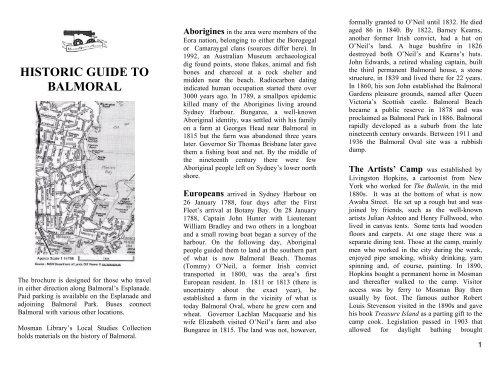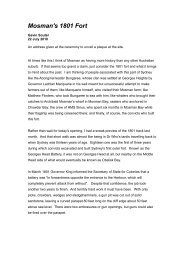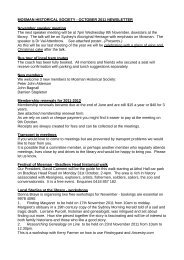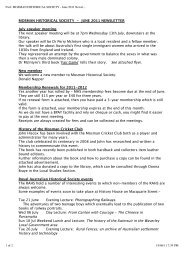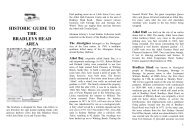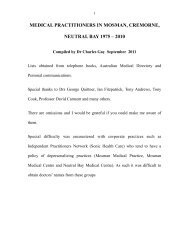Historic Guide to Balmoral (PDF) - Mosman Historical Society
Historic Guide to Balmoral (PDF) - Mosman Historical Society
Historic Guide to Balmoral (PDF) - Mosman Historical Society
You also want an ePaper? Increase the reach of your titles
YUMPU automatically turns print PDFs into web optimized ePapers that Google loves.
HISTORIC GUIDE TO<br />
BALMORAL<br />
The brochure is designed for those who travel<br />
in either direction along <strong>Balmoral</strong>’s Esplanade.<br />
Paid parking is available on the Esplanade and<br />
adjoining <strong>Balmoral</strong> Park. Buses connect<br />
<strong>Balmoral</strong> with various other locations.<br />
<strong>Mosman</strong> Library’s Local Studies Collection<br />
holds materials on the his<strong>to</strong>ry of <strong>Balmoral</strong>.<br />
Aborigines in the area were members of the<br />
Eora nation, belonging <strong>to</strong> either the Borogegal<br />
or Camaraygal clans (sources differ here). In<br />
1992, an Australian Museum archaeological<br />
dig found points, s<strong>to</strong>ne flakes, animal and fish<br />
bones and charcoal at a rock shelter and<br />
midden near the beach. Radiocarbon dating<br />
indicated human occupation started there over<br />
3000 years ago. In 1789, a smallpox epidemic<br />
killed many of the Aborigines living around<br />
Sydney Harbour. Bungaree, a well-known<br />
Aboriginal identity, was settled with his family<br />
on a farm at Georges Head near <strong>Balmoral</strong> in<br />
1815 but the farm was abandoned three years<br />
later. Governor Sir Thomas Brisbane later gave<br />
them a fishing boat and net. By the middle of<br />
the nineteenth century there were few<br />
Aboriginal people left on Sydney’s lower north<br />
shore.<br />
Europeans arrived in Sydney Harbour on<br />
26 January 1788, four days after the First<br />
Fleet’s arrival at Botany Bay. On 28 January<br />
1788, Captain John Hunter with Lieutenant<br />
William Bradley and two others in a longboat<br />
and a small rowing boat began a survey of the<br />
harbour. On the following day, Aboriginal<br />
people guided them <strong>to</strong> land at the southern part<br />
of what is now <strong>Balmoral</strong> Beach. Thomas<br />
(Tommy) O’Neil, a former Irish convict<br />
transported in 1800, was the area’s first<br />
European resident. In 1811 or 1813 (there is<br />
uncertainty about the exact year), he<br />
established a farm in the vicinity of what is<br />
<strong>to</strong>day <strong>Balmoral</strong> Oval, where he grew corn and<br />
wheat. Governor Lachlan Macquarie and his<br />
wife Elizabeth visited O’Neil’s farm and also<br />
Bungaree in 1815. The land was not, however,<br />
formally granted <strong>to</strong> O’Neil until 1832. He died<br />
aged 86 in 1840. By 1822, Barney Kearns,<br />
another former Irish convict, had a hut on<br />
O’Neil’s land. A huge bushfire in 1826<br />
destroyed both O’Neil’s and Kearns’s huts.<br />
John Edwards, a retired whaling captain, built<br />
the third permanent <strong>Balmoral</strong> house, a s<strong>to</strong>ne<br />
structure, in 1839 and lived there for 22 years.<br />
In 1860, his son John established the <strong>Balmoral</strong><br />
Gardens pleasure grounds, named after Queen<br />
Vic<strong>to</strong>ria’s Scottish castle. <strong>Balmoral</strong> Beach<br />
became a public reserve in 1878 and was<br />
proclaimed as <strong>Balmoral</strong> Park in 1886. <strong>Balmoral</strong><br />
rapidly developed as a suburb from the late<br />
nineteenth century onwards. Between 1911 and<br />
1936 the <strong>Balmoral</strong> Oval site was a rubbish<br />
dump.<br />
The Artists’ Camp was established by<br />
Livings<strong>to</strong>n Hopkins, a car<strong>to</strong>onist from New<br />
York who worked for The Bulletin, in the mid<br />
1880s. It was at the bot<strong>to</strong>m of what is now<br />
Awaba Street. He set up a rough hut and was<br />
joined by friends, such as the well-known<br />
artists Julian Ash<strong>to</strong>n and Henry Fullwood, who<br />
lived in canvas tents. Some tents had wooden<br />
floors and carpets. At one stage there was a<br />
separate dining tent. Those at the camp, mainly<br />
men who worked in the city during the week,<br />
enjoyed pipe smoking, whisky drinking, yarn<br />
spinning and, of course, painting. In 1890,<br />
Hopkins bought a permanent home in <strong>Mosman</strong><br />
and thereafter walked <strong>to</strong> the camp. Visi<strong>to</strong>r<br />
access was by ferry <strong>to</strong> <strong>Mosman</strong> Bay then<br />
usually by foot. The famous author Robert<br />
Louis Stevenson visited in the 1890s and gave<br />
his book Treasure Island as a parting gift <strong>to</strong> the<br />
camp cook. Legislation passed in 1903 that<br />
allowed for daylight bathing brought<br />
1
unwelcome crowds and the camp’s demise.<br />
There were other camps elsewhere in <strong>Mosman</strong>.<br />
<strong>Balmoral</strong> Baths were constructed in 1899.<br />
Leased <strong>to</strong> Robert Shearer, they became known<br />
as Shearer's Baths. He also lived in and<br />
managed the Bathers’ Pavilion on its<br />
completion 1929. Men and women initially<br />
bathed separately in the baths.<br />
<strong>Balmoral</strong> Beach Club, located near the<br />
Esplanade’s northern end, was founded in 1914<br />
by a group of seven <strong>Mosman</strong> men who called<br />
themselves ‘The Smugglers’. They set up two<br />
old tram carriages for change rooms and<br />
purchased land <strong>to</strong> erect a timber fenced<br />
clubhouse. The club initially aimed <strong>to</strong><br />
supervise <strong>Balmoral</strong>’s more rowdy visi<strong>to</strong>rs,<br />
provide protection and first aid for beach users<br />
and purchase a patrol boat. Most of these aims<br />
were not achieved and it became a purely<br />
swimming and social organisation. Dave<br />
Smith, a boxer who fought Les Darcy, was a<br />
foundation member.<br />
The Bathers’ Pavilion was opened in<br />
1929. Designed by Alfred H. Hale in a classical<br />
‘Mediterranean’ style, it had 1506 clothing<br />
lockers and 239 cubicles where bathers<br />
disrobed in privacy. It remains largely intact<br />
and now houses one of Sydney’s most highly<br />
regarded restaurants.<br />
Joel’s Boatshed was established by Jack<br />
Joel on the southern side of <strong>Balmoral</strong> Baths in<br />
1923. His father Charles had moved <strong>to</strong> a house<br />
with a shipping cradle near the Baths in the<br />
early twentieth century, building rowing boats<br />
and two schooners.<br />
The Promenade along the Esplanade,<br />
which was completed in 1924, was a response<br />
<strong>to</strong> the influx of new visi<strong>to</strong>rs travelling by tram.<br />
As part of the <strong>Balmoral</strong> Beautification Scheme,<br />
the promenade’s southern section was finished<br />
in 1927 and government employment projects<br />
during the Great Depression helped fund other<br />
sections, the bridge <strong>to</strong> Rocky Point, the<br />
Bathers’ Pavilion and the Rotunda <strong>to</strong> be<br />
completed by 1930.<br />
Public Transport began on a regular<br />
basis in 1905 with daily excursion steamers<br />
from Circular Quay <strong>to</strong> the Spit, s<strong>to</strong>pping at<br />
<strong>Balmoral</strong>. The area’s rugged terrain, however,<br />
meant that it was inaccessible <strong>to</strong> most Sydney<br />
residents until a tramline was established in<br />
1922. The new service greatly increased the<br />
number of visi<strong>to</strong>rs <strong>to</strong> <strong>Balmoral</strong> and put an end<br />
<strong>to</strong> the excursion steamers. Buses replaced<br />
trams in 1958 and the former tram waiting shed<br />
opposite Hunter Park is one of the line’s few<br />
remaining relics.<br />
Queenwood School for girls, which<br />
occupies various sites adjacent <strong>to</strong> <strong>Balmoral</strong><br />
Beach, was opened by Grace Lawrance in a<br />
two-s<strong>to</strong>rey house on Mandolong Road in 1925.<br />
It has grown from 45 pupils in its first full year<br />
<strong>to</strong> more than 700. It was named after a school<br />
in Brigh<strong>to</strong>n, England, operated by her mother.<br />
Beatrice Rennie, who assisted Lawrance, later<br />
succeeded her as the school’s principal.<br />
The Rotunda is a domed structure<br />
designed by Alfred H. Hale. It has Doric<br />
columns standing on a dais. It was initially<br />
used for weekly <strong>Mosman</strong> Municipal Band<br />
concerts and is now frequently the location for<br />
weddings.<br />
The Shark Net, controversially<br />
dismantled in 2008, was built in front of the<br />
Bathers’ Pavilion in 1935 after much public<br />
debate. It provided a steel net enclosure hung<br />
between the end of Rocky Point and a high<br />
tripod opposite the Pavilion’s northern end. In<br />
1955, a shark killed a boy who was checking a<br />
lobster pot not far outside the net off Wy-argine<br />
Point<br />
The Star in the East Amphitheatre,<br />
demolished in 1951, was on a site now<br />
occupied by a block of flats overlooking<br />
Edwards Beach. In the Grecian Doric style, it<br />
was built in 1923 and 1924 for the Order of the<br />
Star in the East, an offshoot of the<br />
Theosophical <strong>Society</strong>. Theosophists seek <strong>to</strong><br />
find God and achieve universal goodwill by<br />
spiritual ecstasy, direct intuition or special<br />
individual relations. The white painted concrete<br />
structure seated 2000 and had room for an<br />
additional 1000 <strong>to</strong> stand. It included a stage, a<br />
chapel, a tearoom, a meeting hall and a library.<br />
The Order intended <strong>to</strong> use the Amphitheatre for<br />
a ‘new world teacher’, Jiddu Krishnamurti, <strong>to</strong><br />
address his audience. He only, though, did so<br />
once and subsequently rejected his role. The<br />
Order was dissolved in 1929. The<br />
Amphitheatre was subsequently sold and used<br />
for concerts and plays.<br />
This work has been assisted by funds allocated <strong>to</strong> the<br />
Royal Australian <strong>His<strong>to</strong>ric</strong>al <strong>Society</strong> by Arts NSW. It<br />
was compiled and published by the <strong>Mosman</strong> <strong>His<strong>to</strong>ric</strong>al<br />
<strong>Society</strong>, PO Box 39, <strong>Mosman</strong> NSW 2088 in 2010.<br />
2


